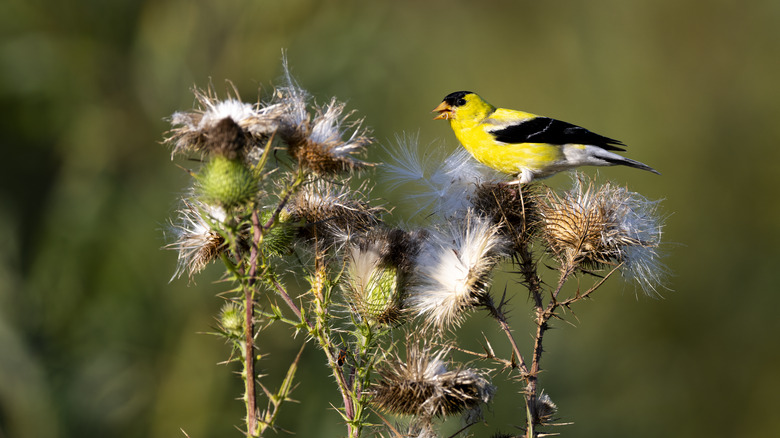Plant These Seed-Bearing Flowers To Attract More Goldfinches To Your Yard
Goldfinches are a favorite of bird enthusiasts for their melodious singing, their striking colors, and their curious but somewhat furtive nature. Attracting finches to your garden is fairly easy if you provide them with the food they like best: seeds! These birds don't eat worms or insects, but feast upon a variety of plant seeds, including Nyjer seeds and seeds from various flowers. Plant seed-producing flowers like asters, coneflowers, zinnias, poppies, marigolds, sunflowers, and cosmos in your garden, and watch the goldfinches come eagerly to feed.
There are three types of goldfinches commonly found in the United States: the American goldfinch, Lawrence's goldfinch, and the lesser goldfinch (which, despite the name, is just as wonderful as the other two). Hanging bird feeders filled with niger seeds (also enjoyed by other types of finches), as well as sunflower chips and birdseed mixes made to attract finches is a good way to get more of these beautiful songbirds. But planting seed-bearing flowers is also an effective draw for these bright birds.
Flowers that produce seeds may also reseed in your garden, and of course birds may help this process along as they transport seeds for eating. In this way, goldfinches can be a boon to the biodiversity of your garden, ensuring a balance of food and shelter for various beneficial birds, insects, and wildlife. Planting flowers to attract and feed goldfinches is not only beneficial to the birds, but increases a gardener's knowledge of, and connection to, the surrounding wildlife.
Planting seed-bearing flowers to attract goldfinches
The great thing about seed-bearing flowers is that not only do they produce seed snacks for birds and other wildlife, they're also effective pollinator attractors. Planting colorful seed-bearing flowers will lure beneficial pollinator insects like bees, moths, and butterflies, as well as hummingbirds. Colorful seed-bearing flowers beloved by goldfinches include perennials like asters, thistles, sedum, and coneflowers, and many sun-loving annuals like zinnias, poppies, sunflowers, cosmos, asters, and marigolds.
There are some birdwatchers who swear that yellow flowers attract goldfinches, but even if that's not proven, some yellow seed-bearing flowers will still make for a colorful, fancy feast for these golden birds. Try planting a variety of sunflowers, bright yellow zinnias (like Canary Bird, or Queeny Lemon Peach), and yellow coneflower varieties such as Sombrero, Mellow Yellows or Summer Solstice. Plant these annuals throughout your garden for bright spots of sunny color and yummy snacks for goldfinches.
To continue planting these flowers to attract goldfinches in subsequent seasons, gather seeds from your late summer annuals for next year. Cosmos, zinnias, and sunflowers all produce abundant seeds that can be gathered, saved, and planted again (just be sure to leave plenty for the birds). You can try planting the seeds indoors to get a head start on the planting season, or just direct sow them in your garden, once the last frost date has passed.
Four seasons of food for goldfinches
Goldfinches are somewhat shy birds, and like to feel safe in their surroundings before they will feed freely on seed snacks. To keep safe from predators or harsh weather, goldfinches tend to seek out shelter, like hedges, shrubs, trees and even brush piles. Thickly branched shrubs attract birds to your yard during the winter season. Planting seed-bearing flowers near these dense shrubs (like forsythia, boxwood, privet, or rose of Sharon) will give these active songbirds a place to perch if they need to take a break in a more sheltered spot.
Once goldfinches feel at ease in their habitat, they will happily eat seeds year round. In spring, they will eat any seeds left from the previous winter. They're also attracted to dandelions, so leave a few of them intact in your yard for early spring food. Once the dandelions go to seed in late spring, goldfinches will eat the seeds, and use the fluff for building their nests. The summer-blooming cup plant is another source of food for them.
Flowers that produce seeds may reseed in your garden, and birds help this process along. In this way, goldfinches strengthen the biodiversity of your garden, ensuring a balance of food and shelter for various beneficial birds, insects, and wildlife. You may observe more flowers reseeding in your garden once you plant varieties with goldfinches in mind: a boon for gardeners and birds alike.


